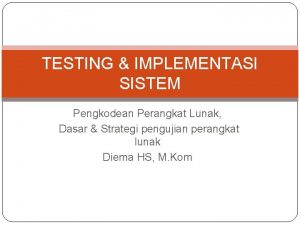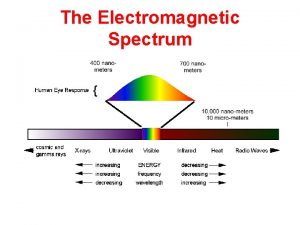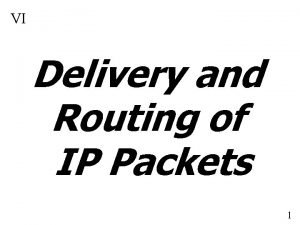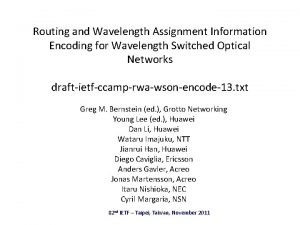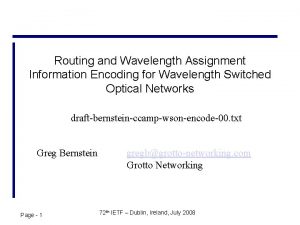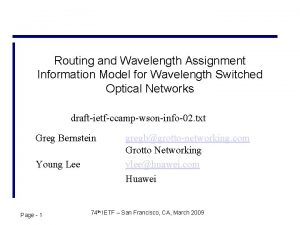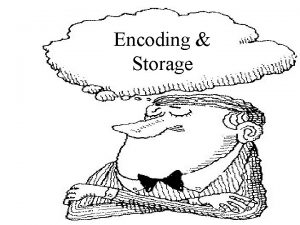Routing and Wavelength Assignment Information Encoding for Wavelength






- Slides: 6

Routing and Wavelength Assignment Information Encoding for Wavelength Switched Optical Networks draft-ietf-ccamp-rwa-wson-encode-01. txt Greg Bernstein Young Lee Page - 1 gregb@grotto-networking. com Grotto Networking ylee@huawei. com Huawei 74 th IETF – San Francisco, CA, March 2009

Authors/Contributors • • • Greg Bernstein (Grotto Networking) Diego Caviglia (Ericsson) Ander Gavler (Acreo AB) Jianrui (Rebecca) Han (Huawei) Young Lee (Huawei) Dan Li (Huawei) Wataru Imajuku (NTT) Jonas Martensson (Acreo AB) Itaru Nishioka (NEC Corp. ) Page - 2 74 th IETF – San Francisco, CA, March 2009

Encoding RWA Info in WSON • Encoding of RWA information – Reduce info transmission burden – Reduce path computation burden • Changes from Encoding 00. txt – Note: accepted as a working group document so file name/number changed. – Edits to make consistent with update to [Otani], i. e. , removal of sign bit. – Clarification of TBD on connection matrix type and possibly numbering. – New sections for wavelength converter pool encoding: Wavelength Converter Set Sub-TLV Wavelength Converter Accessibility Sub. TLV Wavelength Conversion Range Sub-TLVWC Usage State Sub-TLV – Added optional wavelength converter pool TLVs to the composite node TLV. Page - 3 74 th IETF – San Francisco, CA, March 2009

Wavelength Converter Pools Encoding – Uses pairs of lists (bipartite cover like connectivity matrices) but between ingress links and wavelength converters, and between wavelength converters and egress links 0 1 2 3 4 5 6 7 8 9 0 1 +-+-+-+-+-+-+-+-+-+-+-+-+-+-+-+-+ | Num In Pairs | Reserved | +-+-+-+-+-+-+-+-+-+-+-+-+-+-+-+-+ | Ingress Link Set A #1 | +-+-+-+-+-+-+-+-+-+-+-+-+-+-+-+-+ | WC Set A #1 | : : : +-+-+-+-+-+-+-+-+-+-+-+-+-+-+-+-+ | Additional Link set and WC set pairs as needed to | : specify Pool. Ingress. Matrix : +-+-+-+-+-+-+-+-+-+-+-+-+-+-+-+-+ | WC Set B #1 (for egress connectivity) | +-+-+-+-+-+-+-+-+-+-+-+-+-+-+-+-+ | Egress link Set B #1 | : : : +-+-+-+-+-+-+-+-+-+-+-+-+-+-+-+-+ | Additional WC set and egress link set pairs | : as needed to specify Pool. Egress. Matrix : +-+-+-+-+-+-+-+-+-+-+-+-+-+-+-+-+ Page - 4 74 th IETF – San Francisco, CA, March 2009

Wavelength Conversion Range – Used to model physical converter input and output range limits and approximate internal structural constraints as discussed in Minneapolis. 0 1 2 3 4 5 6 7 8 9 0 1 +-+-+-+-+-+-+-+-+-+-+-+-+-+-+-+-+ | Reserved | +-+-+-+-+-+-+-+-+-+-+-+-+-+-+-+-+ | WC Set #1 | +-+-+-+-+-+-+-+-+-+-+-+-+-+-+-+-+ | Input Wavelength Set #1 | +-+-+-+-+-+-+-+-+-+-+-+-+-+-+-+-+ | Output Wavelength Set #1 | : : : +-+-+-+-+-+-+-+-+-+-+-+-+-+-+-+-+ | Additional WC Wavelength constraint set pairs as needed | : : +-+-+-+-+-+-+-+-+-+-+-+-+-+-+-+-+ Page - 5 74 th IETF – San Francisco, CA, March 2009

Next Steps • Review and refine information structure with respect to TLV, sub-sub-TLV etc. Be explicit about what information is infered from TLV header • Refine Encoding of Wavelength Converter Pools – Interconnection structure, Converter properties, Converter ingress/egress constraints, Converter Status • Finalize switch encoding – Multiple fixed and switched blocks or at most one of each? Recommend multiple blocks via numbering. Page - 6 74 th IETF – San Francisco, CA, March 2009
